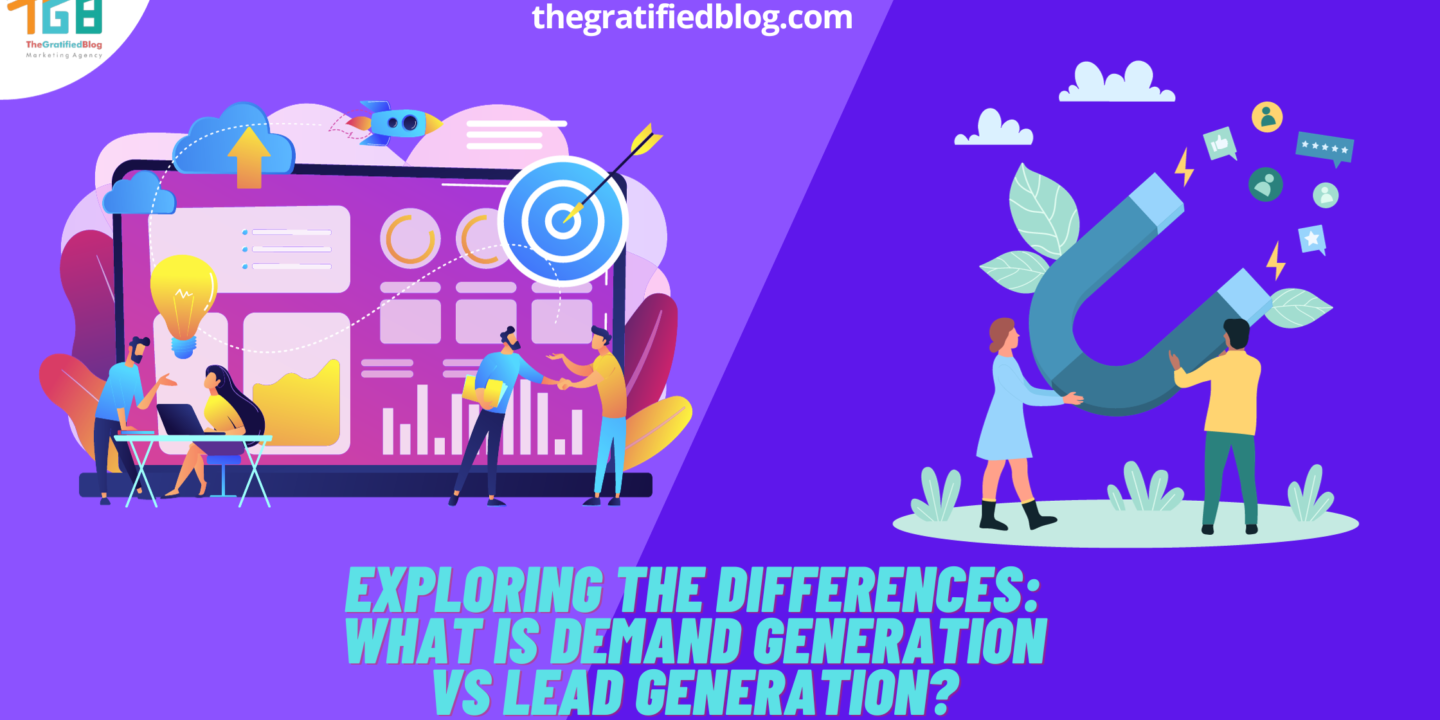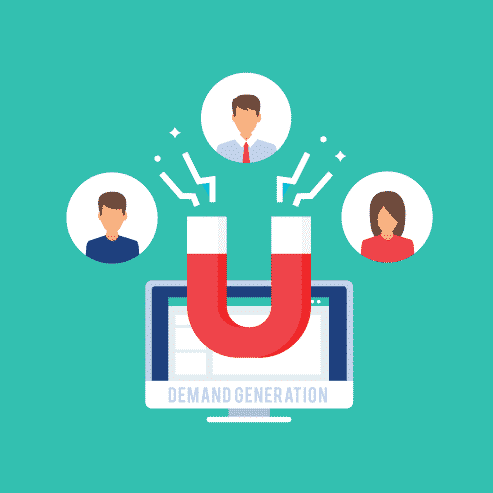
In the dynamic marketing landscape, the terms “demand generation” and “lead generation” frequently emerge. Despite initial appearances of interchangeability, they fulfill unique roles within the broader marketing strategy. Understanding “what is demand generation vs lead generation” is pivotal for businesses aiming to craft impactful marketing campaigns and boost revenue.
This article delves into the nuances of demand generation and lead generation, elucidating their definitions, methodologies, and contributions to overall business success.
Defining Demand Generation

Demand generation is a comprehensive marketing approach focusing on creating awareness and interest in a product or service.
It encompasses a range of activities aimed at building a solid foundation for future sales by engaging and educating potential customers. Unlike lead generation, which focuses on collecting contact information, demand generation is about generating excitement and demand for a product.
Critical Components Of Demand Generation:
- Content Marketing:
Central to demand generation is the creation and dissemination of valuable content. This can manifest in different ways, including blog posts, whitepapers, ebooks, videos, and infographics. The goal is to provide informative and relevant material that positions the brand as an industry authority and addresses the needs and pain points of the target audience. - Social Media Engagement:
Leveraging social media platforms is a fundamental aspect of demand generation. Businesses can elevate their online visibility and foster a community around their brand by actively participating in conversations, sharing, creating valuable content, and engaging with followers. - Search Engine Optimization (SEO):
Optimizing online Optimizing content Optimizing content for search engines is crucial to improving visibility and attracting organic traffic. A well-thought-out SEO strategy ensures that the brand is discoverable by individuals actively searching for relevant information. - Public Relations:
Establishing and sustaining positive connections with the media can significantly contribute to demand generation. Press releases, interviews, and media coverage help establish credibility and reach a broader audience. - Events And Webinars:
Hosting or engaging in events and webinars provides opportunities to connect with the audience more interactively. This engagement helps build relationships with potential customers and showcase the brand’s expertise. - Email Marketing:
While often associated with lead generation, email marketing also influences demand generation. Businesses can nurture leads and keep their brand top-of-mind by delivering targeted and personalized content to a segmented audience.
The Purpose Of Demand Generation:
The primary aim of demand generation is to establish a buzz around the brand, generating interest and curiosity among the target audience. It establishes the foundation for creating brand awareness, establishing credibility, and positioning the company as a valuable resource.
While demand generation may yield only short-term, tangible results, its impact is evident in the long term as it contributes to a robust brand presence and a steady influx of leads.
Defining Lead Generation

Lead generation is a more specific and targeted strategy to identify and collect potential customers’ contact information.
The objective is to facilitate lead generation, acquiring leads—individuals or businesses who have expressed interest in the product or service and have the potential to become paying customers.
Critical Components Of Lead Generation:
- Forms And Landing Pages:
Lead generation often involves the creation of dedicated landing pages and forms on a website. These forms capture essential information such as names, email addresses, and sometimes more detailed data about a prospect. - Content Upgrades:
Offering valuable content upgrades, such as ebooks, guides, or exclusive access to webinars, motivates visitors to share their contact details in return for the valuable resource. - Webinars And Demos:
Hosting webinars or providing product demonstrations allows businesses to gather leads from individuals actively engaged with the content. - Email Marketing Campaigns:
Harness the potency of email marketing as an influential tool for lead generation. Businesses can use targeted email campaigns to nurture leads, provide relevant information, and guide prospects through the sales funnel. - Social Media Advertising:
Running targeted ads on social media platforms allows businesses to reach specific demographics and drive interested individuals to dedicated landing pages where their information can be captured.
The Purpose Of Lead Generation:
The main objective of lead generation is to obtain the contact information of potential customers. This information enables businesses to initiate direct communication, foster leads, and steer them through the stages of the sales funnel.
Unlike demand generation, lead generation is more immediate in its impact, providing a direct channel for sales teams to engage with potential customers.
What Is Demand Generation vs Lead Generation?
Demand generation and lead generation are related concepts in marketing, but they serve different purposes in the overall sales and marketing process. Let’s explore the differences between demand generation and lead generation:
Definition
- Demand Generation: This broader term encompasses marketing activities crafted to generate awareness and stimulate interest in a product or service. Demand generation aims to create demand for your offering in the market. It involves building brand awareness, educating the audience about the product or service, and creating a positive perception.
- Lead Generation: This is a more specific aspect of demand generation. Lead generation focuses on identifying and capturing potential customers or leads demonstrating interest in your product or service. The aim is to gather information about these prospective leads and lead them through the progression of the sales funnel.
Scope
- Demand Generation: It covers a wide range of activities throughout the entire customer journey, from building initial awareness to post-purchase engagement. It involves creating a favorable environment for sales by fostering a positive brand image.
- Lead Generation: A more targeted process explicitly identifies and captures potential customers likely to convert into sales. Demand generation encompasses lead generation as one of its components.
Goals
- Demand Generation: The primary goal is to create awareness, build brand equity, and establish a positive perception in the market. It aims to generate interest and demand for the product or service.
- Lead Generation: The primary goal is to collect information about potential customers (leads) who have expressed interest in the product or service. The ultimate objective is to convert these leads into customers.
Metrics
- Demand Generation: Metrics may include brand awareness, website traffic, social media engagement, and overall market reach. Success is often measured in increased market share and positive brand sentiment.
- Lead Generation: Metrics include the quantity of generated leads, conversion rates, and the caliber of leads. Success is measured by how many leads are successfully converted into paying customers.
Timing
- Demand Generation: A long-term strategy focuses on building and maintaining a brand presence over time. Results may take time to be apparent.
- Lead Generation: It often has more immediate and tangible outcomes, as it involves identifying potential customers closer to purchasing.
Interconnections exist between demand generation and lead generation; demand generation has a broader emphasis on generating market interest and building brand awareness.
Lead generation explicitly targets identifying and capturing potential customers to drive conversions. Both constitute integral elements of a well-rounded marketing approach.
Choosing The Right Mix For Your Business

The optimal mix of demand and lead generation depends on various factors, including the nature of the business, target audience, industry, and overall marketing objectives. Here are some considerations for businesses when determining the right balance:
Stage Of Business Growth
- Early Stage:
- Startups and enterprises in the initial phases of development may prioritize demand generation to build brand awareness and establish themselves in the market.
- Established Stage:
- Established businesses may focus on lead generation to sustain a consistent influx of potential customers and drive immediate sales.
Nature Of The Product Or Service
- High-Consideration Products:
- Products or services that require significant consideration and research may benefit more from a robust demand-generation strategy.
- Impulse Buy Products:
- Lead generation efforts can be more direct and immediate for products with a shorter decision-making process.
Target Audience
- B2B (Business-to-Business):
- B2B businesses may prioritize demand generation to establish thought leadership and credibility within their industry.
- B2C (Business-to-Consumer):
- B2C businesses might emphasize lead generation to capture consumer interest and drive sales quickly.
Sales Cycle Length
- Long Sales Cycle:
- Industries with longer sales cycles may find that demand generation is crucial for
- We are maintaining a presence throughout the extended decision-making process.
- Short Sales Cycle:
- Businesses with shorter sales cycles may lean more towards lead generation to capture immediate opportunities.
Budget Considerations
- Budget Constraints:
- Businesses with limited budgets may need to strike a balance but could initially focus on the approach that aligns with their immediate goals.
- Flexible Budget:
- Those with more flexibility in their budget can explore a combination of demand and lead generation strategies for a comprehensive approach.
Challenges And Considerations
- Balancing Act:
- Finding the optimal equilibrium between demand generation and lead generation is vital. Overemphasis on one at the expense of the other can lead to an imbalanced funnel, where there is either a lack of interest in the market or a failure to convert interested prospects into leads.
- Quality vs. Quantity:
- A common challenge is balancing the quality and quantity of leads. While lead generation efforts may succeed in generating a high volume of leads, their quality is paramount. Businesses must focus on attracting leads that align with their target customer profile to ensure a higher conversion rate.
- Adaptability:
- The digital environment is ever-changing, and consumer behavior evolves. Marketing strategies must be adaptable to changing trends, technologies, and consumer preferences. Regular assessment and strategy adjustment are essential to stay ahead in the competitive landscape.
- Technology Integration:
- Implementing and integrating the right marketing technologies, including platforms such as Customer Relationship Management (CRM) and marketing automation tools, is critical for effective lead nurturing and management. Ensuring these tools work seamlessly together is vital for a cohesive marketing strategy.
Real-world Examples:
- Demand Generation Example:
- Consider a tech company launching a new software solution for project management. Their demand generation strategy might involve creating blog posts and social media content highlighting traditional project management challenges, the benefits of using project management software, and general industry trends.
- Webinars featuring experts discussing the future of project management could also be part of the demand generation efforts. These activities aim to create awareness, educate the audience, and position the company as a thought leader.
- Lead Generation Example:
- Following the demand generation phase, the tech company shifts to lead generation. They may create a gated whitepaper that delves into their project management software’s specific features and advantages. Prospects interested in accessing this in-depth content must provide their contact information.
- The company can then use this information to initiate targeted email campaigns, offering product demos, exclusive discounts, or other incentives to move these prospects further down the funnel.
FAQ’S
Q1. What Are The Two Types Of Lead Generation?
Ans: Lead generation generally falls into two primary categories:
- Inbound Lead Generation: Involves attracting potential customers through content marketing, SEO, and social media. This method focuses on creating valuable and relevant content to draw prospects to your business.
- Outbound Lead Generation: In this approach, businesses actively reach out to potential customers. This can include cold calling, email marketing, and targeted advertising. Outbound strategies are more direct and involve initiating contact with potential leads.
Q2. What Is The Difference Between Demand Generation And Brand Generation?
Ans: Demand generation creates awareness and interest in a product or service to drive immediate customer action.
It typically involves targeted marketing efforts to generate leads and promote sales. On the other hand, brand generation is centered around building and enhancing a company’s overall brand image.
It aims to establish a robust and positive perception of the brand, fostering long-term customer loyalty and trust. While demand generation aims for immediate conversions, brand generation focuses on the broader, sustained impact on brand reputation and customer relationships.
Both are crucial elements of a comprehensive marketing strategy, working together to drive short-term results and long-term brand value.
Q3. How Do You Generate Demand And Leads?
Ans: Generating demand and leads involves strategic efforts to attract prospective customers and generate interest in your products or services.
Utilize digital marketing avenues like social media SEO and content marketing to establish a digital presence and engage your target audience.
Leverage targeted advertising campaigns to connect with precise demographics and generate interest. Employ email marketing to nurture leads and provide valuable content that addresses customer needs.
Offer incentives or promotions to encourage customer engagement and capture their contact information. Analyze data and feedback to refine your strategies and optimize your lead generation efforts.
Conclusion
Understanding demand and lead generation distinctions is crucial for businesses creating effective and targeted campaigns in the ever-evolving marketing landscape.
While concentrating on demand generation, the emphasis is on constructing brand awareness and interest; lead generation focuses on capturing contact information and driving immediate sales.
The synergy between these two approaches is where the true power lies. By seamlessly integrating demand and lead generation strategies, organizations can formulate an all-encompassing marketing strategy that addresses long-term brand building and immediate revenue generation.
The key is to analyze the unique characteristics of the business, industry, and target audience to determine the optimal mix for sustained growth and success.
Whether a startup looking to establish its presence or a well-established enterprise aiming to sustain a competitive advantage, finding the right balance between demand and lead generation is essential for unlocking the full potential of a marketing strategy.
Also read: A Complete Guide To Know How To Start A Lead Generation Business?








No Comments